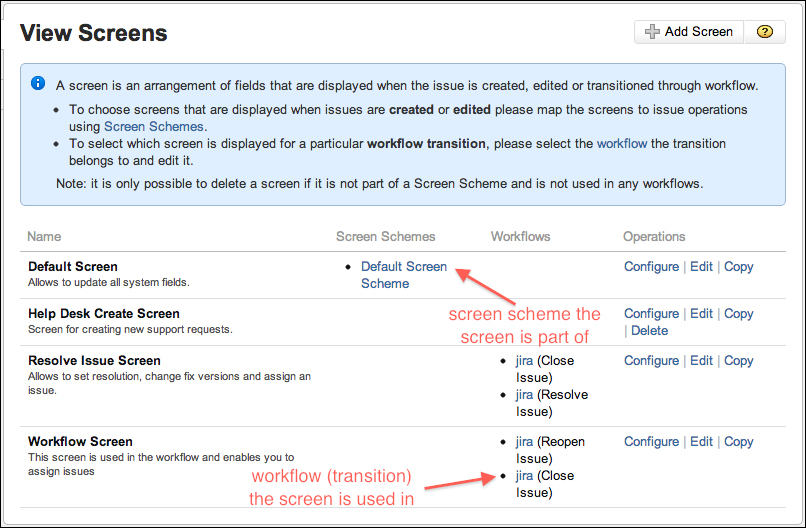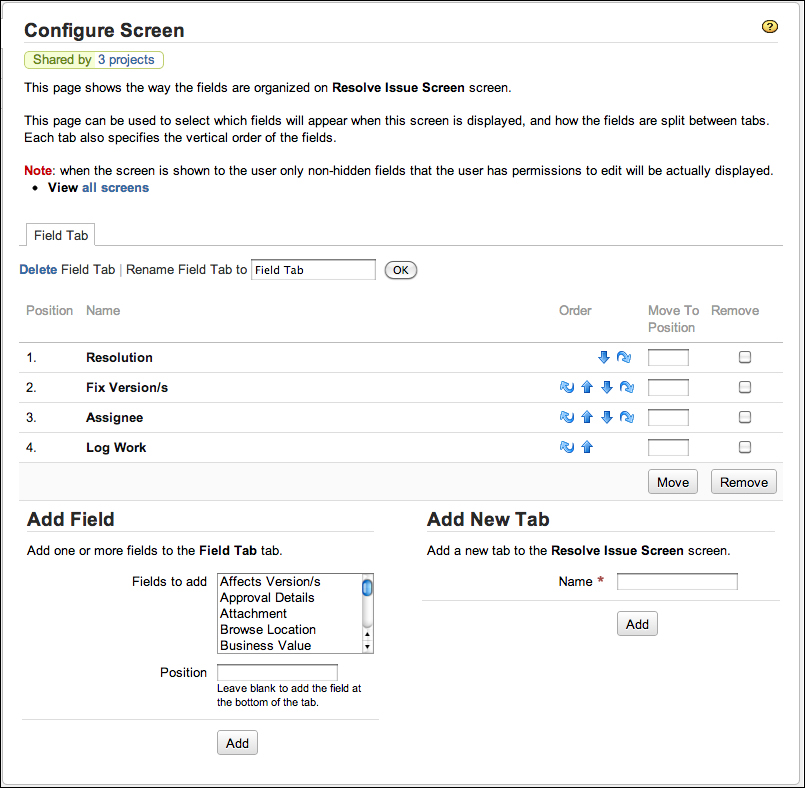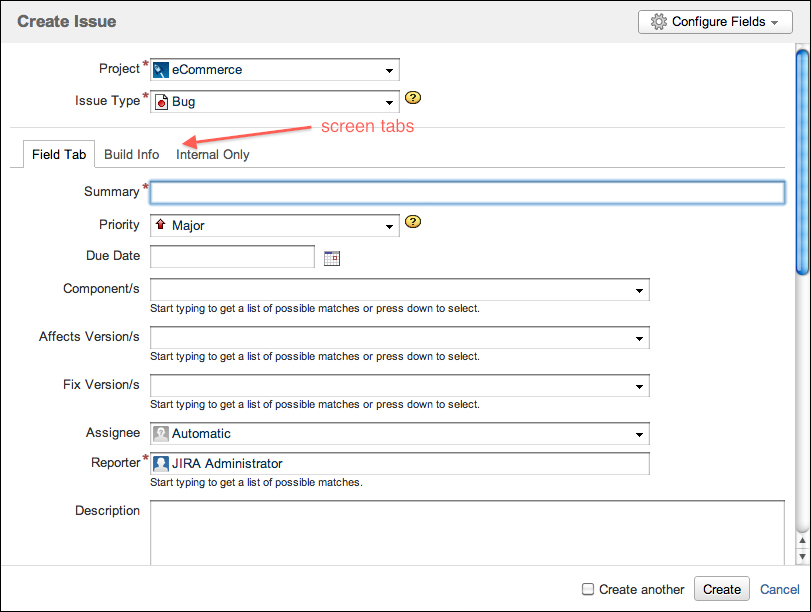While many other software systems provide users with limited control over the presentation of screens, JIRA is very flexible when it comes to screen customizations. You can create your own screens and decide what fields are to be placed on them and their orders. You can also decide which screens are to be displayed for major issue operations. In JIRA, you can create and design customized screens for the following operations:
- Create an issue in the create issue dialog box.
- Edit an issue when an issue is being updated.
- View an issue after an issue is created and is being viewed by users.
- Manage workflows during workflow transitions (workflows will be covered in Chapter 6, Workflows and Business Processes).
Screens are maintained centrally from the administration console, which means you need to be a JIRA administrator to create and configure screens. Perform the following steps to access the screens page:
- Log in to JIRA as a JIRA administrator.
- Click on Administration at the top menu bar.
- Click on Screens in the Screens section to bring up the View Screens page.
The View Screens page lists all the existing screens in your JIRA. From here, you can create new screens, configure what fields should be on these screens, and decide how you can divide a screen into various tabs.
For each of the screens listed here, JIRA will also tell you what screen scheme each of the screens are a part of and the workflows that are being used. You have probably noticed for screens that are either part of a screen scheme or workflow, there is no Delete option available, as you cannot delete screens that are in use. You need to unassociate the screen from screen schemes and/or workflows to delete them:

JIRA comes with three screens by default. You have already seen them while creating a new issue, resolving an issue, and transitioning an issue through a workflow. As a matter of fact, if you have not made any customizations to screens, every issue screen you see will be one of the following:
While these screens are able to cover the most basic requirements, you will soon find yourself outgrowing them, and adjustments will need to be made. For example, if you want keep certain fields, such as priority, read-only, so that they shouldn't be changed after issue creation, you can achieve this by setting up different screens for creating and editing issues. Another example will be to have different create and edit screens for different issue types, such as bug and task. In these cases, you will need to create your own screen in JIRA:
- Browse to the View Screens page.
- Click on the Add Screen button. This will bring up the Add Screen dialog box.
- Provide a meaningful name for the new screen. It is a good idea to name your screen after its purpose, for example,
Bug Create Screento indicate that it is the screen for creating new bug issues. - Provide an optional short description for the screen.
- Click on the Add button to create the screen.
At this point, your new screen is blank with no fields in it. You will see in later sections how to add fields onto screens and put them to use.
You can edit existing screens to update their details to help keep your configurations up to date and consistent. Perform the following steps to edit a screen:
- Browse to the View Screens page.
- Click on the Edit link for the screen you wish to update. This will take you to the Edit Screen page.
- Update the name and description of the screen.
- Click on the Update button to apply your changes:

To delete an existing screen, it must not be used by any screen schemes or workflows. If it is associated with a screen scheme or workflow, you will not be able to delete it. You will need to undo the association first. Perform the following steps to delete a screen:
By deleting a screen, you do not delete the fields that are on the screen.
Screens can be complicated with many of fields ordered logically, so creating a new screen from scratch may not be the most efficient method if there is already a similar one available. Just like with many other entities in JIRA, you can make a copy of an existing screen, thus cutting down the time that would otherwise take you to re-add all the fields:
- Browse to the View Screens page.
- Click on the Copy link for the screen you wish to copy. This will take you to the Copy Screen page.
- Provide a new name and description for the screen.
- Click on the Copy button to copy the screen:

Creating a new screen is like getting a blank piece of paper; the fun part is to add and arrange the fields on the screen. Fields in JIRA are arranged and displayed from top to bottom in a single column when you are on the create and edit screen, while for the view screen, fields are groups together by type. You have full control of what fields should be added and in what order they should be arranged. Furthermore, JIRA allows you to break your screens into tabs or "pages within a form", and you can do all of this within a single configuration page. It is this level of flexibility combined with its simplicity that makes JIRA a very powerful tool.
Perform the following steps to configure an existing screen:
- Browse to the View Screens page.
- Click on the Configure link for the screen you wish to configure:

On this page, you can do the following:
- Add/remove fields onto the screen
- Arrange the order of the fields
- Create/delete tabs on the screen
- Move fields from one tab to another
When you first create a screen, it is of little use. In order for screens to have items to present to the users, you must first add fields onto the screens:
- Browse to the Configure Screen page for the screen you wish to configure.
- Select the fields you would like to place on the screen in the Add Field section.
- Optionally, specify the position where you would like to add those fields. If you do not specify a position, fields will be added at the bottom of the screen.
- Click on the Add button to add fields to the screen.
Fields can be taken off from a screen completely. When a field is taken off, the field will not appear when the screen is presented to the users. There is a subtle difference between deleting a field from a screen and hiding it (discussed in the previous chapter). Although both the actions will prevent the field from showing up, by removing the field, issues will not receive a value for that field when they are created. This becomes important when a field is configured to have a default value. When the field is removed, the issue will not have the default value for the field, while if the field is simply hidden, the default value will apply.
You will also need to pay close attention to not delete the required fields, such as summary, from a screen used to create new issues. As seen in Chapter 4, Field Management, JIRA will prevent you from hiding fields that are marked as required, but JIRA does not prevent you from taking the required fields off the screen. So, it is possible for you to end up in a situation where JIRA requires a value for a field that does not exist on the screen. This can lead to very confusing error messages to the end users:
By default, fields are displayed from top to bottom, where new fields are added to the bottom. As your requirements for the screen design continue to evolve, the order of fields may need to be rearranged to flow more logically.
JIRA provides two methods for you to move fields around on a screen. You can move a field up and down one position at a time, or you can specify the position where you would like to place the field.
Perform the following steps to move a field up and down one position at a time:
- Browse to the Configure Screen page for the screen you wish to configure.
- Click on the up and down arrow icon for the field you wish to move.
You can also click on the Move to First and Move to Last arrows to move the field instantly to the top and bottom of the list respectively.
When your list of fields are long, instead of clicking multiple times to move your field to the desired position, you can specify where you would like it to go directly, as follows:
- Browse to the Configure Screen page for the screen you wish to configure.
- Specify the desired position in the Move To Position field for the field you would like to move (first field has a value of 1).
- Click on the Move button to move the field.
You can specify positions to move multiple fields at once, however, you cannot specify the same position value for more than one field.
For most cases, you will be sequentially adding fields to a screen, and users will fill them from top to bottom. However, there will be cases where your screen becomes over complicated and cluttered due to the sheer number of fields you need, or you simply want to have a way to logically group several fields together and separate them from the rest. This is where tabs come in.
If you think of screens as the entire form a user must fill in, then tabs will be individual pages or sections that make up the whole document. Tabs go from left to right, so it is a good practice to design your tabs to flow logically from left to right. For example, the first tab can gather general information, such as summary and description. Subsequent tabs will gather more domain-specific information:

You can add tabs to any screen in JIRA. In fact, by default, all screens have a default tab called Field Tab that is used to host all the fields. You can add new tabs to a screen to break down and better manage your screen presentation:
- Browse to the View Screens page.
- Click on the Configure link for the screen you wish to add a new tab for.
- Provide a meaningful name for the new tab in the Add New Tab section at bottom of the page.
- Click on the Add button to create the tab.
Once a tab is created, you will be able to add fields to it.
Just like screens, you can maintain existing tabs by editing their names and/or removing them from the screen. Perform the following steps to edit a tab's name:
- Browse to the View Screens page.
- Click on the Configure link for the screen that has the tab you wish to edit.
- Select the tab.
- Provide a new name for the tab.
- Click on the OK button to apply the change.
When you delete a tab, the fields that are on the tab will be taken off the screen. You will need to re-add or move them to a different tab if you still want those fields to appear on the screen. You cannot delete the last tab on the screen:
- Browse to the View Screens page.
- Click on the Configure link for the screen that has the tab you wish to edit.
- Select the tab.
- Click on the Delete link. This will take you to the Delete Screen Tab page for confirmation.
- Click on the Delete button to remove the tab from the screen:

Tabs are organized horizontally from left to right. When you add a new tab to the screen, they are appended to the end of the list. So, there will be times when you will need to reshuffle them around, so that your screen flow makes more sense to the users. Perform the following steps to change the orders of your tabs:
- Browse to the View Screens page.
- Click on the Configure link for the screen with tabs you wish to reorder.
- Select the tab you would like to move.
- Click on either the left or right arrow to move the tab.
When you move tabs around, their fields will move along with the tabs.
